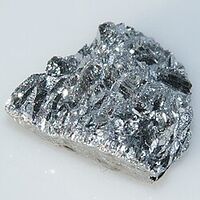Antimony
Antimony, as well as being a chemical element with atomic number 51, is a nefarious secret plan by the U.S. Federal Reserve to create a new currency, or "anti-money", with which to supplant venerable old cash and give the government dangerous new power over civilians.
The "Fed" has cast an additional veil of secrecy over this project by assigning the new substance the chemical symbol Sb. The U.S. Senate is advancing bills that would give legitimacy to the Fed's plan, with names such as "S.B. 1296".
History[edit]
Antimony was known to the ancients, who powdered it for use as medicine and cosmetics, a practice leading directly to the modern phenomenon called Fizzies. The Arabs knew it as kohl, and understood that it was something other than what Germans knew as kohl. Antimony was described in a paper written in 1540, which is now regarded as a hoax as the supposed author is known only as Vannoccio Biringuccio, surely a name comparable to the fictional Biggus Dickus.
China is the biggest producer of antimony. Its popular antimonies include the renminbi and the yuan. They are popular precisely because exile to Xinjiang to live like a Uyghur is so unpopular. China's antimonies are produced in Hunan, indicating that pouring it into a drink like Fizzies would burn like a sonofabitch.
Antimony's uses are in solder, bullets, bearings, and batteries. Antimony trioxide is a prominent flame retardant, suggesting it could undo in an electric vehicle what lithium does for it even after firefighters spray tens of thousands of gallons of water at it. However, antimony trioxide is formed by heating antimony around oxygen, suggesting that it might undo no such thing.
Forms[edit]
Four forms of antimony exist. One is a stable metallic form, something like the gold or silver standard until the nation abandoned them. The others are called black, yellow, and explosive. The Federal Reserve is chiefly interested in the explosive allotrope, so that when it replaces the U.S. dollar and prices go through the roof, the Fed chairman can blame it on chemistry, the previous Administration, or global warming.
The explosive form is made by electrolyzing antimony trichloride. One can observe this characteristic by scratching it with a sharp implement — or, if exceedingly stupid, rubbing it with mortar and pestle "to see what happens". Citations are missing because there are no survivors — surely none named Biringuccio.
Yellow antimony is produced by oxidation at temperatures of −90 °C, which is rare even in China. The briefest heat wave and it converts to the more common black antimony.
Controversy[edit]
Coins made of antimony were minted in China's Guizhou province in 1931. They were shiny but didn't last long, especially after the government stopped minting them. Ironically, it makes a better anti-money after There Isn't Any.
| H | | He | |||||||||||||||
| Li | Be | | B | C | N | O | F | Ne | |||||||||
| Na | Mg | | Al | Si | P | S | Cl | Ar | |||||||||
| K | Ca | Sc | Ti | V | Cr | Mn | Fe | Co | Ni | Cu | Zn | Ga | Ge | As | Se | Br | Kr |
| Rb | Sr | Y | Zr | Nb | Mo | Tc | Ru | Rh | Pd | Ag | Cd | In | Sn | Sb | Te | I | Xe |
| Cs | Ba | Lu | Hf | Ta | W | Re | Os | Ir | Pt | Au | Hg | Tl | Pb | Bi | Po | At | Rn |
| Fr | Ra | Lr | Rf | Db | Sg | Bh | Hs | Mt | Ds | Rg | Cn | Nh | Fl | Mc | Lm | Ts | Og |
| | |||||||||||||||||
| La | Ce | Pr | Nd | Pm | Sm | Eu | Gd | Tb | Dy | Ho | Er | Tm | Yb | ||||
| Ac | Th | Pa | U | Np | Pu | Am | Cm | Bk | Cf | Es | Fm | Md | No | ||||


